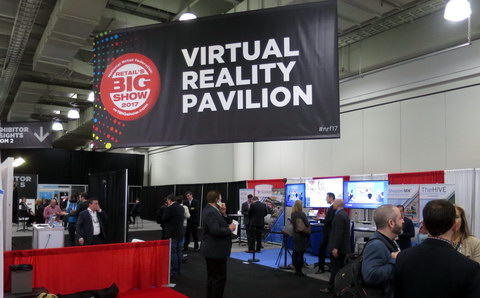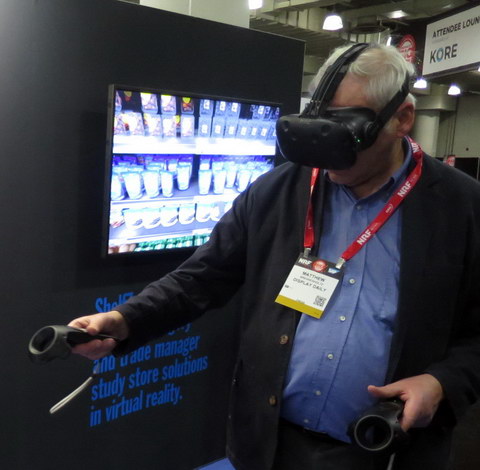There was a small VR pavilion at the NRF Big Show with three exhibitors InContext Solutions, InVRsion and Marxent Labs. A fourth company, Timelooper, Inc. had reserved a booth but did not show up, perhaps because they are not a B2B company but are selling VR content on the App Store and Google Play. In addition to their own booth, InContext was also showing their HMD-based VR solutions in the Intel booth. Coincidentally, or perhaps not, all three companies in the VR pavilion were using HTC Vive headsets and the accompanying controller. When I commented on how the resolution of the headset was not really enough for the VR application, the exhibitors said it was enough for now but they were looking forward to the next-generation of headset with higher resolution and eye tracking.

InContext Solutions was using the VR HMD not for sales to consumers but for research with their ShopperMX VR software (InContext Gets $15 million for VR in Retail). InContext customers can build virtual stores and use them to study various store layouts and shelf arrangements. According to the InContext rep at the NRF show, results of VR studies have about a 0.9 correlation with in-store studies and VR studies are much easier to do than building simulated stores or doing studies in real stores off-hours. The company says, “InContext Solutions is the global leader in scalable cloud-based virtual reality (VR) shopping and retail solutions, dedicated to providing decision-critical insights for manufacturers and retailers. In a time when brick-and-mortar stores are being challenged by the rapidly evolving world of e-commerce, we have revolutionized the way companies understand shopper behavior.” In addition to VR market research, the company also provides in-store touch screen displays (not VR displays) along the line of “Endless Aisle” displays, described later in this report.
 Meko’s Matt Brennesholtz in the InContext booth wearing a HTC Vive HMD and holding two HTC controllers. The controllers allowed manipulating virtual packages picked up on the virtual shelves in the virtual store.
Meko’s Matt Brennesholtz in the InContext booth wearing a HTC Vive HMD and holding two HTC controllers. The controllers allowed manipulating virtual packages picked up on the virtual shelves in the virtual store.
InVRsion has a product called ShelfZone that is a store simulator similar to the one from InContext (VR Used for Retail Planning). It allows companies to do market research in virtual stores and test store layouts, shelf arrangements, etc. Like InContext and Marxent, they used HTC Vive headsets and controllers. The company has similar products called CarZone and ResiZone that target the automotive industry and the residential real estate industries, respectively. ResiZone is used primarily as a marketing tool that allows customers to view and select furnishings and finishes for real estate that hasn’t even been built yet. An interesting feature of ResiZone is it includes binaural audio that can render the sound ambience of a room and simulate the effect of soundproofing systems. As could be expected, only ShelfZone was being demonstrated at the NRF show.
 Meko’s Matt Brennesholtz is testing InVRision’s ShelfZone and selecting an item from a virtual shelf with the HTC controller.
Meko’s Matt Brennesholtz is testing InVRision’s ShelfZone and selecting an item from a virtual shelf with the HTC controller.
Marxent Labs was demonstrating what they called VisualCommerce, which was the use of VR and AR as sales aids. They have posted several videos on YouTube showing different aspects of their VisualCommerce concept. This system was available for a variety of platforms including VR headsets; large touch screens in kiosks; desktop and laptop computers; and hand-held devices like smartphones and tablets. Marxent also has posted a video on their website about how their VR and AR can help retailers and also provide analytics on what customers are interested in. While they were using a HTV Vive HMD at the NRF show, their videos show Oculus HMDs in use. The HMD-based VR they were showing at the NRF show had been created for Ashley Furniture Industries, said to be the #1 furniture manufacturer in the world. The application was similar to ResiZone from InVRsion and allowed consumers to visualize furniture in a house that hadn’t been built yet. Toll Brothers, a luxury home builder in the US, was another customer for this product.
Consumer in an empty room using VisualCommerce AR on a tablet to envision how a piece of furniture would look.(Source: Marxent Labs)

